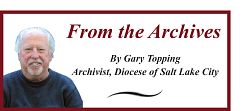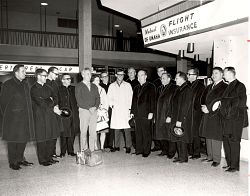Cathedral of the Madeleine bulletins document how the changes of Vatican II were accommodated
Friday, Jun. 17, 2016
Issued on Dec. 4, 1963, the Constitution on the Sacred Liturgy was the third of the 16 documents initiated by the Second Vatican Council, and the first to be completed and promulgated, thus indicating the urgency liturgical reform held in the minds of the Council Fathers.
Although the council reforms affected virtually every aspect of the life of the Church, it was this one that had the most conspicuous, immediate and practical effect on all Catholics – clergy, religious and laity.
The timing was fortunate, for the new liturgy was to go into effect the first Sunday of Advent, Nov. 29, 1964, which gave the Church almost a year to prepare for the change.
While all parishes, including those in Utah, were affected, preservation of the weekly parish bulletins at the Cathedral of the Madeleine gives us a well-documented glimpse of the ways in which one parish made its accommodations.
Because the Right Rev. Joseph L. Federal, sixth Bishop of Salt Lake, was in Rome participating in the council, preparations at the cathedral fell into the hands of the rector, Msgr. William H. McDougall, Jr.
It is likely to strike us Catholics today as humorous that the biggest obstacle seems to have been the singing of hymns in English, particularly on the part of the congregation. As early as Oct. 4, practice sessions in congregational singing were held 10 minutes before each Mass.
Things seem not to have gone very well in the beginning, and by Nov. 15, Msgr. McDougall was desperately urging that “all must be ready Nov. 29 ... so, practice today – sing out – speak out.”
Nor was congregational singing the only problem, for the cathedral’s Oct. 11 bulletin contained an appeal for strong new voices to join the men’s choir, because “the changes in the liturgy put new and unprecedented demands upon the choir.”
The degree and timing of the implementation of the changes was left up to the discretion of the local bishop, depending on his reading of the circumstances in his diocese. When the Intermountain Catholic published an outline of the new liturgy for Utah on what it called “E-day” (English Day), only about half of the liturgy had been converted to the vernacular; the rest remained in Latin.
Nevertheless, it was enough to cause considerable consternation, for everything depended upon the timely arrival of missals and hymnals in English, and for people to have time to wrap their minds around the new texts. For seven weeks prior to Nov. 29, pamphlets explaining aspects of the new liturgy were stapled to the bulletins (unfortunately, none seems to have survived), and “inexpensive laminated folders bearing the English responses” in the Mass were offered to anyone who wished to update their old missals rather than buying new ones.
Not the least remarkable aspect of the transition was the fact that Bishop Federal returned from Rome only on Nov. 24, which gave him just five days to prepare for rolling out the new liturgy. Although he was well aware of the changes, having participated in all four sessions of the council, he would have had little opportunity to practice.
Although there were, and still are, those who have objected to the changes, those objections were largely quelled when Pope Paul VI himself demonstrated the new liturgy at an outdoor Mass in Yankee Stadium on Oct. 4, 1965 and attendees could see how well it worked. Since that time, most of us think the new liturgy, including most of the additional changes subsequently added, has been one of the most effective ways in which the ancient Church has remained relevant to the modern world.
For questions, comments or to report inaccuracies on the website, please CLICK HERE.
© Copyright 2024 The Diocese of Salt Lake City. All rights reserved.
© Copyright 2024 The Diocese of Salt Lake City. All rights reserved.



Stay Connected With Us